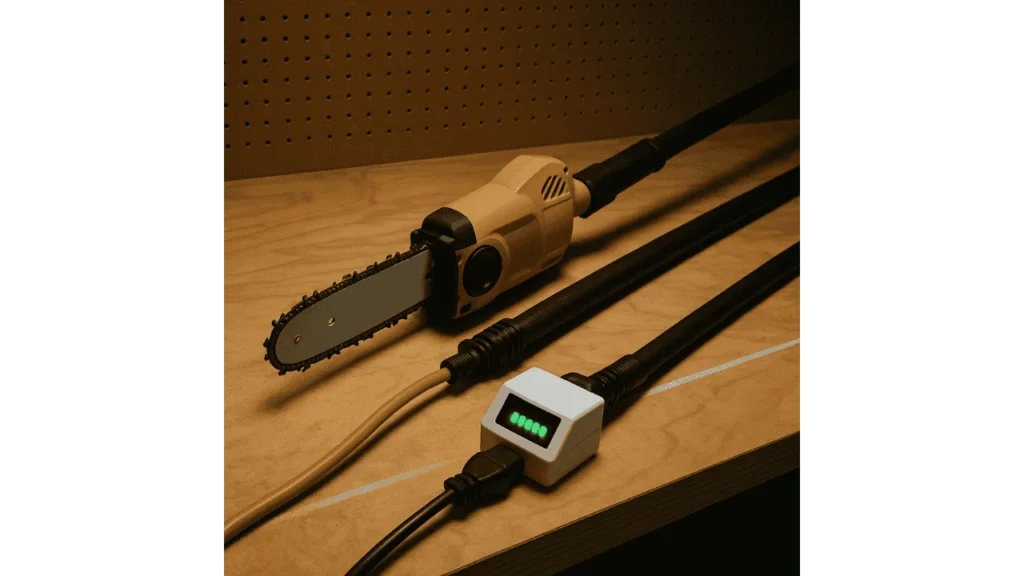Understanding the wattage of a pole saw is crucial when selecting the right tool for your yard work. Wattage determines how much electrical power the motor draws and, by extension, how efficiently it cuts. Whether you’re plugging into a wall socket or using a battery pack, knowing how much energy the saw uses ensures compatibility with your extension cords, batteries, and power sources.
“Matching your tool’s power demand with the right cord or battery isn’t just about performance; it’s about preventing damage and ensuring safety.” — David Knox, Electrical Tools Safety Consultant

How Much Power Does a Corded Electric Pole Saw Use?
Corded electric models are known for their consistent power supply. Most fall within a predictable wattage range.
Wattage Range: 720 to 960 Watts (6 to 8 Amps)
Most standard models, like the PowerSmart 8-inch saw, are rated at 720 watts (derived from 6 amps × 120 volts). Popular brands like Sun Joe and Greenworks typically use 6 to 8-amp motors, translating to 720 to 960 watts. These models provide reliable cutting performance without battery concerns.
How Amps and Volts Influence Power?
Wattage is a product of current and voltage. For instance, 6 amps × 120 volts = 720 watts, while 8 amps = 960 watts. Higher amp saws usually offer better cutting power and are more suited for denser branches and tougher pruning jobs.
How Much Power Does a Cordless Pole Saw Use?
Cordless or battery-powered pole saws offer flexibility and portability but come with different power considerations.
Battery-Powered Wattage: 500 to 1000 Watts Equivalent
Lower-end units like the Tegatok mini pole saw operate at around 550 watts, while high-voltage systems (40V to 60V) deliver up to 900 watts or more, offering performance comparable to corded models.
Battery Runtime and Power Draw
A 500 to 1000-watt draw means a 2Ah, 40V battery (80 watt-hours) lasts about 4.8 to 8 minutes at full load, not accounting for efficiency losses. Larger capacity batteries (4Ah or more) are recommended for longer cutting sessions.
How Does Wattage Affect Performance?
Cutting Capacity and Efficiency
Pole saws rated 720 to 960 watts can typically handle branches up to 6 to 8 inches thick. Heavier-duty units with higher wattage can manage denser wood more efficiently, making the task faster and cleaner.
“More watts generally mean faster cuts, but also more weight and shorter battery life. Balance is key.” — Laura Meng, Outdoor Power Tools Engineer
Electrical Demands and Circuit Limits
Corded saws drawing 6 to 8 amps require circuits that can safely handle up to 10 amps to avoid breaker trips. Cordless tools, on the other hand, demand batteries with matching voltage and amp-hour capacity to deliver sufficient runtime without strain.
How to Choose the Right Wattage for Your Needs?
If you only handle light pruning, a 720-watt corded saw (6 amps) will be sufficient. For medium cutting tasks, go for an 8-amp corded model (~960 watts) or a 500 to 700-watt battery model. Heavier tasks or frequent usage call for 900 to 1000 watts or more, especially if you’re working with thick, stubborn limbs.
Practical Tips for Using Pole Saws Safely
Higher wattage means more power, but also more motor weight and vibration. With corded models, ensure you have a high-quality extension cord rated for the tool’s amps. With cordless units, select batteries with sufficient amp-hours to match your cutting time, avoiding frequent recharging interruptions.
Final Takeaways
A typical electric pole saw uses 720 to 960 watts if corded and 500 to 1000 watts equivalent if cordless. Choosing the right power level ensures safe, efficient operation based on your pruning needs. Balance the task demands, available power supply, and your comfort preferences when selecting a model, and you’ll get both better results and a safer experience.
- How to Cut a Straight Line with a Jigsaw? - October 31, 2025
- How to Cut a Circle with a Jigsaw? - October 31, 2025
- Can You Cut Acrylic with a Jigsaw? - October 31, 2025
